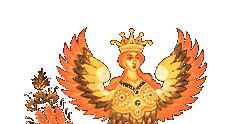According to E. I. Itkina in her book "Loubok - Russian Popular Prints" on page 16:
One of the more popular Loubok scenes were of sweet-voiced, half-birds half-maidens named Siren and Alconost. These scenes were drawn during the middle of the 18th century through the beginning of the 19th century. Artists who painted the Loubok prints not only copied popular lithograph originals but created original compositions of these heavenly birds.
Original depictions of the Siren birds are based on legends and stories from the Chronograph books. According to these books, the voice of the maiden-bird is so sweet that a man who hears this song forgets everything, begins following the bird, and without the ability to control himself he eventually collapses and dies of exhaustion from pursuing the bird.
The artist usually depicts a man entranced by the Siren bird's song, which is sitting on a flower and fruit covered bush. In the lower portion of the drawing, underneath the bush the man is lying dead at the hands of the bird.
With noise people would try to scare these birds away by beating drums, blow horns, fire cannons, and some prints depicted people ringing large church bells. The loud noises would frighten the Siren birds that would leave earth and head back to their heavenly dwelling.
The other heavenly bird, Alconost, is similar to Siren with the only difference was that it had hands. Alconost very often would carry a scroll in her hands, with proverbs of redemption from heaven for a spiritual life on earth. According to legend the Alconost had a similar effect on people, as did the Siren. "Whoever will be near this being, will forget everything of this world, his mind will leave along with his soul..." - from a subtitle on a Loubok print on (pic. 20)
Using common sense experts and people alike, believe that in folk art the Siren is the bird of joy, and Alconost is the bird of sorrow. This contradiction is incorrect since it is not based on the symbolism of the images. When analyzing various books, chronicles, and works of folk art (murals, icons, and hand-sewn pieces) it becomes clear that Alconost never represents sorrow. This contradiction was more or less created by a famous painting by V.M. Vasnetsov "Siren and Alconost. The Song of Joy and Sorrow (1896)". In the artist's depiction of the two birds he depicts a dark bird and an illuminated bird, the illuminated one joyful, the dark one sad. This is the first time these birds were used in a representation of a contradiction in feelings. Nowhere in folk art can such a comparison be found. This flawed practice started in professional art, which used ancient symbols without having a complete understanding of their deeper meanings.
|



